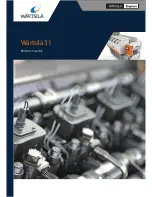
21.5
Starting air vessel and piping
The starting air system should be designed so that explosion is
prevented.
An oil and water separator should be included in the feed pipe
between the compressor and the starting air vessel. At the bottom
point of the piping there should be a drain valve.
Drain the starting air vessel from condensate through the drain
valve before starting.
The piping between the air vessels and the engines should be
carefully cleaned when installing. Also later on they should be
kept free from dirt, oil and condensate.
The starting air vessels should be inspected and cleaned with
intervals according to chapter 04. If possible, they should then be
coated with a suitable anti-corrosive agent. Let them dry long
enough.
At the same time, inspect the valves of the starting air vessels.
Too strong tightening may result in damage on the seats, which
in turn causes leakage. Leaky and worn valves including safety
valves should be reground. Pressure test the safety valves.
The filter (20), Fig 21-1, on the engine should be inspected and
cleaned with intervals according to chapter 04. Drain the filter
from condensate with the built-on drain valve.
21.6
Pneumatic system
21.6.1 General description
The engine is equipped with a pneumatic system for control of the
following functions by means of identical solenoid valves:
•
start of the engine
•
stop of the engine
•
starting fuel limitation
•
change-over of the thermostat valve.
The system includes a filter (12), an vessel (6) and a non-return
valve (11) to ensure the pressure in the system in case of lacking
feed pressure.
The main starting valve (8), which is described in detail in
section 22.2, is actuated by the solenoid valve (3) at remote start.
Fig 21-3 shows the solenoid valve. The valve is equipped with a
push button and can be energized manually.
At the same time as the main starting valve is actuated, an
impulse goes to the automatic water separator, which opens
during the starting cycle to expel condensated water separated
by the filter (12).
The starting fuel limiter (15) is described in detail in chapter
22., section 22.7. During the starting cycle it is automatically
22-9601
Starting Air System
21
VASA 22
21-5
Summary of Contents for Vasa R22
Page 14: ...Appendix B Welding Precautions 200147 00 4...
Page 42: ...02 Fuel Lubricating Oil Cooling Water 22 9601 02 22 VASA 22...
Page 60: ...03 Start Stop and Operation 22 9632 03 12 VASA 22...
Page 72: ...04 Maintenance Schedule 22 9845 III 04 12 MD HF...
Page 92: ...06 II Adjustments Clearances and Wear limits 22 9601 06 6 VASA 22...
Page 116: ...08 Operating Troubles Emergency Operation 22 9601 08 8 VASA 22...
Page 144: ...11 Crank Mechanism 22 9601 11 18 VASA 22...
Page 156: ...12 Cylinder Head with Valves 22 9601 12 12 VASA 22...
Page 164: ...13 Camshaft Driving Gear 22 9601 13 8 VASA 22...
Page 172: ...14 Valve Mechanism and Camshaft 22 9601 14 8 VASA 22...
Page 183: ...22 200520 Turbocharging and Air Cooling 15 VTR Turbocharger 15 11...
Page 189: ...15 III Turbocharging and Air Cooling 22 8604 15 6 VTR 161 251 Turbochargers...
Page 209: ...17 Fuel system 22 9601 17 8 VASA 22...
Page 229: ...18 Lubricating Oil System 22 9601 18 20 VASA 22...
Page 247: ...19 Cooling Water System 22 9601 19 18 VASA 22...
Page 261: ...21 Starting Air System 22 9601 21 10 VASA 22...
















































